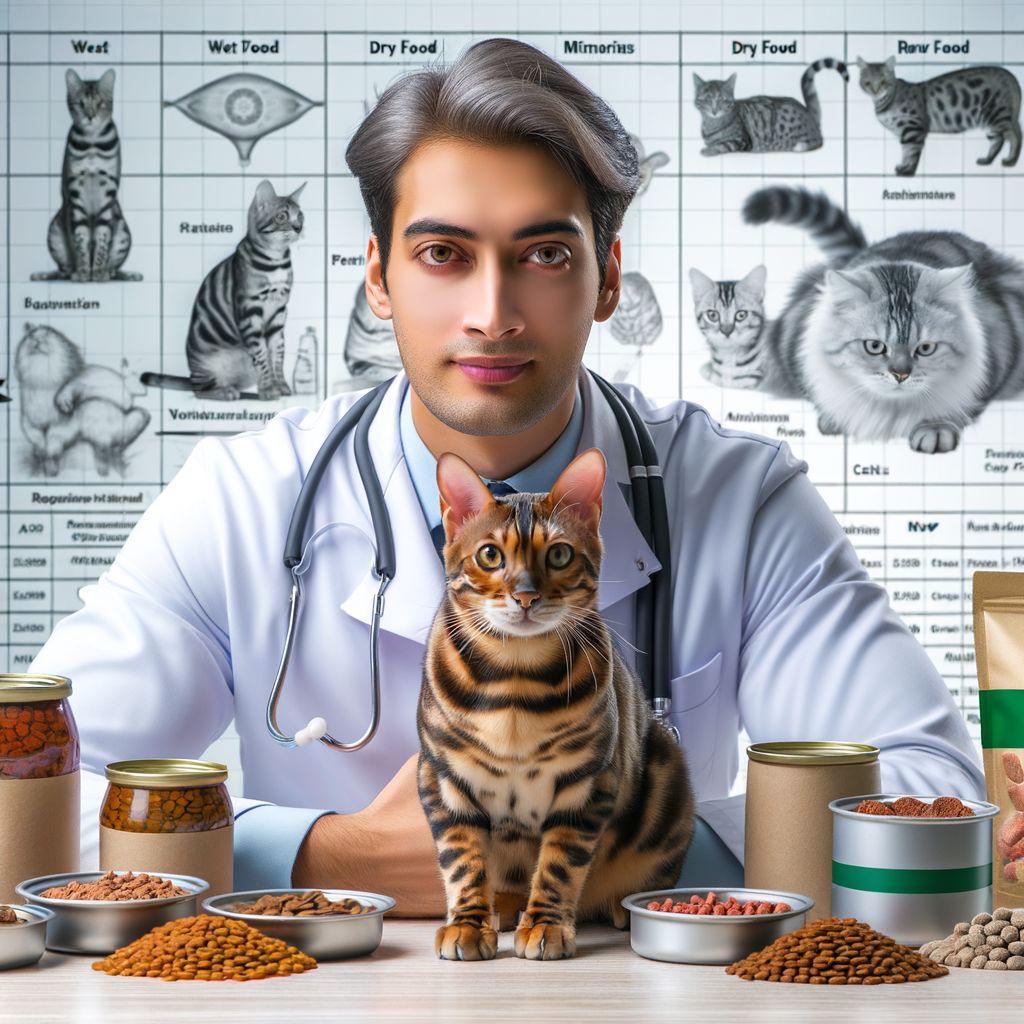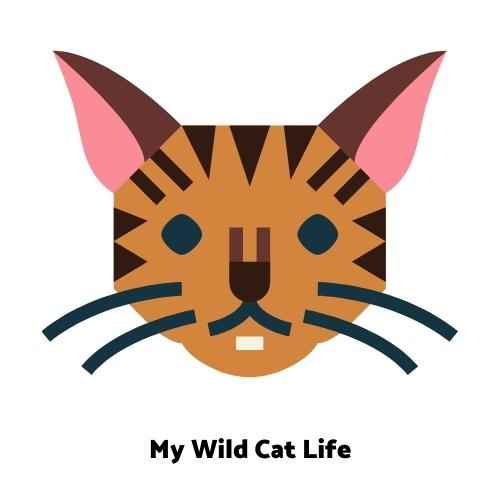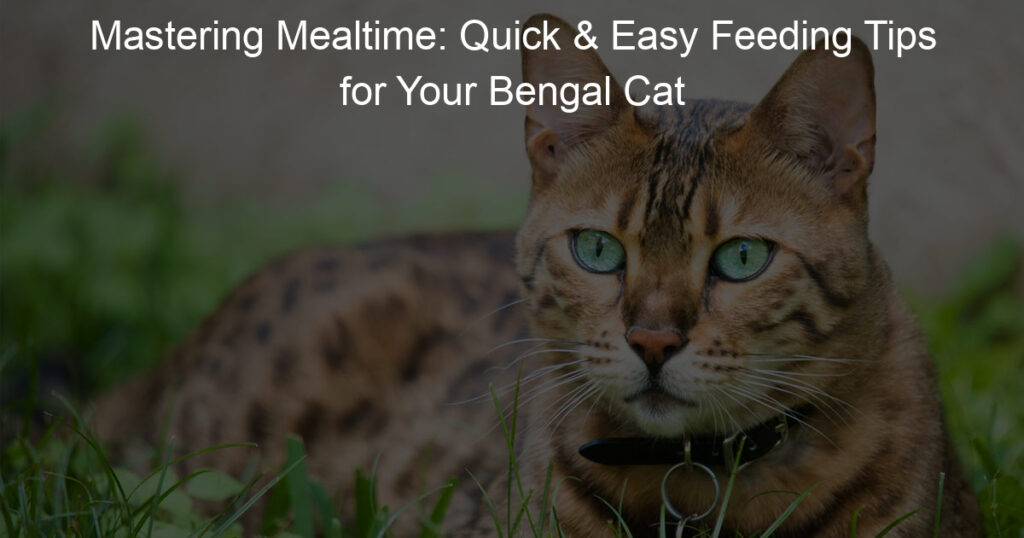
Introduction to Bengal Cat Nutrition
When it comes to keeping your Bengal cat healthy and vibrant, nutrition plays a crucial role. Understanding the dietary needs of your Bengal cat and providing a balanced diet can significantly contribute to their overall well-being. This article will guide you through the importance of a balanced diet and an overview of Bengal cat dietary needs.
Just like humans, cats also need a balanced diet to maintain their health. A balanced diet for a Bengal cat includes the right proportions of proteins, fats, carbohydrates, vitamins, and minerals. These nutrients are essential for their growth, energy, and overall health. For instance, proteins help in building strong muscles, while fats provide energy. Vitamins and minerals are vital for various bodily functions like digestion, immunity, and bone health.
Bengal cats have unique dietary needs compared to other breeds. They require a diet high in protein, as they are descendants of wild leopards. They also need a good amount of moisture in their diet, which is why wet food is often recommended. Bengal cats also benefit from a diet low in carbohydrates. It’s important to note that every Bengal cat is unique, and their dietary needs may vary based on factors like age, weight, and health conditions. Therefore, it’s always best to consult with a vet to determine the most suitable diet for your Bengal cat.
In the following sections, we will delve deeper into the Bengal cat diet, provide helpful food tips, discuss the healthy diet for Bengal cats, guide you on feeding, and recommend some food options. By the end of this article, you will be well-equipped to master your Bengal cat’s mealtime.
Understanding Bengal Cat Diet
When it comes to Bengal cats, their diet plays a crucial role in their overall health and well-being. Understanding the basics of feeding your Bengal cat is the first step towards ensuring they live a healthy and happy life.
Feeding Bengal Cats: The Basics
Feeding your Bengal cat isn’t just about what you feed them, but also how often and how much. Let’s delve into these important aspects.
-
- How often to feed your Bengal cat
Typically, adult Bengal cats should be fed twice a day, once in the morning and once in the evening. However, kittens require more frequent meals, usually three to four times a day, due to their rapid growth and high energy levels.
-
- Portion sizes for different ages and sizes
The portion size of your Bengal cat’s meals will depend on their age, size, and activity level. Kittens and young cats usually need more food relative to their body weight, while older cats may need less. A general guideline is to feed about 2-4% of the cat’s body weight daily, but always consult your vet for personalized advice.
Remember, every cat is unique and may have different dietary needs. It’s always best to consult with a veterinarian to ensure your Bengal cat’s nutritional needs are being met.
What to Feed Bengal Cats
Feeding your Bengal cat the right food is crucial for their health and happiness. Let’s delve into the types of food recommended for Bengal cats and the ingredients you should avoid.
- Recommended Types of Food
Bengal cats are known for their active and playful nature. They require a diet that is rich in protein to support their energy levels. Here are some recommended types of food:
- High-quality Dry Cat Food: Dry cat food is a convenient option that provides essential nutrients. Look for brands that list a source of animal protein, like chicken or fish, as the first ingredient.
- Wet Cat Food: Wet cat food is a great source of hydration and is often more palatable to cats. It can be used in combination with dry food.
- Raw or Cooked Meat: Bengal cats can benefit from the inclusion of raw or cooked meat in their diet. This mimics their natural diet in the wild and provides a rich source of protein.
- Ingredients to Avoid
While it’s important to know what to feed your Bengal cat, it’s equally important to know what not to feed them. Here are some ingredients to avoid:
- Grains: Cats are obligate carnivores, which means their bodies aren’t designed to digest grains. Foods with corn, wheat, or soy should be avoided.
- Artificial Additives: Artificial colors, flavors, and preservatives can cause health issues in cats. Always choose natural, high-quality cat food.
- Dairy Products: Many cats are lactose intolerant, which means they can’t digest dairy products. Avoid giving your Bengal cat milk or cheese.
Remember, every cat is unique and may have different dietary needs. Always consult with your vet before making significant changes to your Bengal cat’s diet.
Bengal Cat Food Tips
Feeding your Bengal cat correctly is crucial for their overall health and well-being. Here are some tips to help you choose the best food for your Bengal cat.
Choosing the Best Food for Bengal Cats
Choosing the right food for your Bengal cat can be a daunting task, given the numerous options available in the market. However, by following these two key steps, you can make an informed decision.
- Reading food labels
Just like human food, cat food labels contain a wealth of information about the ingredients and nutritional content. Look for high-quality protein sources such as chicken, beef, or fish listed as the first ingredient. Avoid foods with artificial colors, flavors, or preservatives. Also, check for the AAFCO (Association of American Feed Control Officials) statement, which ensures the food meets the minimum nutritional requirements for cats.
- Considering your cat’s age, size, and health
Your Bengal cat’s age, size, and health status are critical factors when choosing their food. Kittens require food high in protein and fat to support their rapid growth and development. Adult cats, on the other hand, need a balanced diet to maintain their weight and health. Senior cats may require a diet low in calories but high in fiber and certain nutrients. If your cat has a specific health condition, such as diabetes or kidney disease, they may need a special diet. Always consult your vet before making any significant changes to your cat’s diet.
Remember, every cat is unique, and what works for one may not work for another. It’s important to monitor your Bengal cat’s reaction to a new diet and adjust accordingly. A healthy diet is the foundation of a long, happy life for your Bengal cat.
Transitioning to a New Diet
When it comes to Bengal cats, changing their diet can be a delicate process. It’s important to do it right to ensure your cat stays healthy and happy. Here are some steps to follow for a smooth transition and signs to watch out for that may indicate food intolerance or allergies.
-
- Steps for a Smooth Transition
Switching your Bengal cat to a new diet should be done gradually to avoid upsetting their digestive system. Here’s a simple step-by-step guide:
-
-
- Step 1: Start by mixing a small amount of the new food with the old food. A good ratio to start with is 25% new food and 75% old food.
- Step 2: Over the next week, gradually increase the amount of new food while decreasing the amount of old food.
- Step 3: By the end of the week, your cat should be eating 100% new food. If your cat is hesitant or refuses to eat, slow down the transition process.
- Signs of Food Intolerance or Allergies
-
While transitioning your Bengal cat to a new diet, it’s important to watch out for signs of food intolerance or allergies. These can include:
-
- Diarrhea or vomiting: If your cat is having frequent bouts of diarrhea or vomiting, they may be intolerant to something in the new food.
- Itchy skin or coat: If your cat is constantly scratching or their coat looks dull and lifeless, they may be allergic to an ingredient in the new food.
- Lethargy: If your cat seems unusually tired or uninterested in play, they may not be feeling well due to a food intolerance or allergy.
Remember, every cat is different and may react differently to a new diet. Always consult with your vet if you’re unsure about a new diet or if your cat is showing signs of food intolerance or allergies.
Healthy Diet for Bengal Cats
Feeding your Bengal cat a balanced and nutritious diet is crucial for their overall health and well-being. A well-rounded diet can significantly improve their quality of life, ensuring they remain active, healthy, and happy.
Benefits of a Balanced Diet
A balanced diet for your Bengal cat can provide numerous benefits. Let’s take a closer look at some of the most important ones:
- Improved energy levels: A diet rich in high-quality proteins and fats can help boost your Bengal cat’s energy levels. Proteins are essential for growth and repair, while fats provide a concentrated source of energy. With the right diet, your Bengal cat will have the energy to play, explore, and engage in their natural behaviors.
- Longer lifespan: A balanced diet can also contribute to a longer lifespan for your Bengal cat. Proper nutrition can help prevent obesity and related health issues, such as diabetes and heart disease. By feeding your cat a balanced diet, you’re giving them the best chance at a long, healthy life.
Remember, every cat is unique, and what works for one might not work for another. It’s important to monitor your Bengal cat’s health and adjust their diet as necessary. Consult with your vet to determine the best diet plan for your Bengal cat.
Supplementing Your Bengal Cat’s Diet
Just like humans, our feline friends, specifically Bengal cats, may need a little extra help in the nutrition department. This is where supplements come in. They are designed to fill any nutritional gaps in your cat’s diet, ensuring they get all the vitamins and minerals they need to stay healthy. But when and why should you use supplements? And what supplements are recommended for Bengal cats? Let’s find out.
- When and why to use supplements
Supplements should be considered when your Bengal cat’s diet is not providing all the necessary nutrients. This could be due to a variety of reasons such as poor quality cat food, certain health conditions, or age-related issues. For instance, older cats may require supplements to support joint health, while cats with digestive issues may benefit from probiotics.
However, it’s important to remember that supplements should not replace a balanced diet. They are there to complement the diet and provide additional nutrients that your Bengal cat may be lacking. Always consult with your vet before starting any supplement regimen to ensure it’s necessary and safe for your cat.
- Recommended supplements
There are several supplements that can benefit Bengal cats, but the specific ones your cat needs will depend on their individual health needs. Here are a few commonly recommended supplements:
| Supplement | Benefits |
|---|---|
| Omega-3 Fatty Acids | Supports skin and coat health, reduces inflammation, and aids in brain development. |
| Probiotics | Helps maintain a healthy gut flora, supports digestion, and boosts the immune system. |
| Glucosamine | Supports joint health and can be beneficial for cats with arthritis. |
Remember, always consult with your vet before introducing any new supplements into your Bengal cat’s diet. They can provide guidance on the right types and dosages for your cat’s specific needs.
Bengal Cat Feeding Guide
Feeding your Bengal cat correctly is crucial to their health and happiness. This guide will help you understand the importance of a consistent feeding schedule and how to adjust it as your cat ages.
Feeding Schedule
Just like humans, Bengal cats thrive on routine, especially when it comes to their meals. Let’s delve into the details of creating a consistent feeding schedule and adjusting it as your cat ages.
-
- Creating a consistent feeding schedule
A consistent feeding schedule is essential for your Bengal cat’s wellbeing. It helps regulate their metabolism and keeps them in good health. Aim to feed your cat at the same times each day. For instance, you might choose to feed them once in the morning and once in the evening. This consistency will help your cat know when to expect food and can reduce anxiety and behavioral issues.
-
- Adjusting the schedule as your cat ages
As your Bengal cat grows older, their dietary needs will change. Kittens require more frequent meals – up to four times a day – because they are growing rapidly. As they transition into adulthood, you can reduce this to two meals a day. Senior cats may require more frequent, smaller meals to help manage health conditions. Always consult your vet when making significant changes to your cat’s feeding schedule.
In conclusion, a well-planned feeding schedule that adjusts to your Bengal cat’s age and health needs can contribute significantly to their overall wellbeing. Remember, every cat is unique, so it’s essential to monitor your cat’s response to their feeding schedule and make adjustments as needed.
Monitoring Your Bengal Cat’s Weight
Keeping an eye on your Bengal cat’s weight is a crucial part of maintaining their health. Regular weight checks and understanding what to do if your cat is overweight or underweight are key steps in this process.
- Regular Weight Checks
Regular weight checks are a must for your Bengal cat. This can be done at home using a pet scale or during regular vet visits. Monitoring your cat’s weight can help you notice any sudden changes, which could be a sign of health issues. For instance, a sudden weight loss could indicate a problem with your cat’s digestion, while a sudden weight gain could be a sign of overfeeding or lack of exercise.
- What to do if Your Cat is Overweight or Underweight
If your Bengal cat is overweight, it’s important to consult with your vet to create a diet and exercise plan. Overweight cats are at risk for health issues like diabetes and arthritis. On the other hand, if your cat is underweight, this could be a sign of malnutrition or illness. Again, consult with your vet to ensure your cat is getting the right nutrients and to rule out any health issues.
| Weight Status | Action |
|---|---|
| Overweight | Consult with vet, create diet and exercise plan |
| Underweight | Consult with vet, ensure proper nutrition, rule out health issues |
In conclusion, monitoring your Bengal cat’s weight is an essential part of their health care. Regular weight checks and knowing what to do if your cat is overweight or underweight can help ensure your cat lives a long, healthy life.
Bengal Cat Food Recommendations
When it comes to feeding your Bengal cat, choosing the right food is crucial. Here, we will explore some of the top-rated brands that offer high-quality cat food suitable for your Bengal’s unique dietary needs.
Top Rated Brands
These brands have been carefully selected based on their nutritional content, customer reviews, and popularity among Bengal cat owners.
-
- Brand 1: Purina Pro Plan
Purina Pro Plan is a well-known brand that offers a wide range of cat food options. Their formulas are packed with high-quality protein sources, like real chicken or fish, and contain no artificial colors or flavors. This brand is highly recommended for Bengal cats due to its focus on nutrition and taste.
-
- Brand 2: Royal Canin
Royal Canin is another top-rated brand that provides specialized nutrition for Bengal cats. Their Bengal Breed Adult dry cat food is designed with the specific needs of Bengal cats in mind, including support for their muscular build and a complex of antioxidants for their health.
Remember, every cat is unique and may have different dietary needs. Always consult with your vet before making any changes to your Bengal cat’s diet.
Homemade Food Options
While there are many high-quality cat food brands available, some Bengal cat owners prefer to prepare homemade meals for their feline friends. Here are two simple and nutritious recipes you can try at home.
- Recipe 1: Chicken and Pumpkin StewThis recipe is packed with protein from chicken and fiber from pumpkin, making it a balanced meal for your Bengal cat.
Ingredients Instructions - 1 cup of chicken breast, diced
- 1/2 cup of pumpkin, diced
- 1 cup of water
- Boil the chicken and pumpkin in water until cooked.
- Let it cool and serve it to your cat.
- Recipe 2: Tuna and Peas MixThis recipe is a great source of omega-3 fatty acids from tuna and vitamins from peas.
Ingredients Instructions - 1 can of tuna in water
- 1/4 cup of peas
- Mix the tuna and peas together.
- Serve it to your cat at room temperature.
Remember, homemade food should be prepared with fresh ingredients and served in appropriate portions. Always consult with your vet before introducing new foods into your Bengal cat’s diet.
Conclusion: Mastering Your Bengal Cat’s Mealtime
As we wrap up this comprehensive guide on Bengal cat nutrition, let’s take a moment to recap the key takeaways and share some final thoughts on this important topic.
-
- Recap of Key Takeaways
Understanding your Bengal cat’s nutritional needs is crucial for their health and happiness. We’ve learned that this unique breed requires a diet rich in protein, with minimal carbohydrates. We’ve also discovered the importance of hydration and how wet food can contribute to meeting this need.
Feeding your Bengal cat isn’t just about what you feed them, but also how and when. Regular feeding times, portion control, and avoiding human food are all essential aspects of a Bengal cat’s mealtime.
We’ve also explored some recommended food brands that cater to the specific dietary needs of Bengal cats. Remember, every cat is unique, so it’s important to monitor your pet’s reaction to a new diet and adjust as necessary.
-
- Final Thoughts on Bengal Cat Nutrition
Bengal cat nutrition is not a one-size-fits-all approach. It requires understanding, patience, and a willingness to adapt. As a responsible Bengal cat owner, your goal should be to provide a balanced diet that meets your cat’s specific needs.
Remember, a healthy diet contributes significantly to your Bengal cat’s overall well-being, influencing their energy levels, coat health, and even their lifespan. So, take the time to master your Bengal cat’s mealtime – your furry friend is worth it!
In conclusion, Bengal cat nutrition is a vast and complex topic, but with the right knowledge and approach, you can ensure your Bengal cat thrives. Here’s to happy, healthy mealtimes for your Bengal cat!














